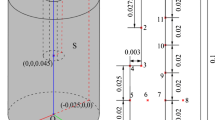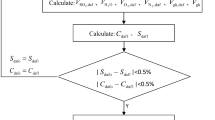Abstract
Based on the unsteady state heat transfer model, production solution method is proposed to calculate the thermal diffusivity and thermal conductivity of loose coal. By constructing the heat transfer model of the infinite large plate and the infinitely long cylinder, the temperature rise formula of the production solution method is established. The measured temperature rise is then used by the MATLAB programming software to inversely calculate the thermophysical parameters of the loose coal. During the experiment, a constant temperature boundary was constructed using an incubator and a high thermal conductivity copper cylindrical case. The experiment selected anthracite, bituminous coal in Panyi Mine, and bituminous coal in Lizuo Mine for thermophysical property measurement. The results show that the relative deviation between each measurement result and related literature is within 5 %, and each sample is tested three times. The deviations are less than 5 %, which verify the stability of the test method. Finally, the experimental model was established in the ANSYS FLUENT simulation software, and the thermophysical parameters of the measured coal samples were substituted into the model for simulation calculation. It was found that the simulation temperature rise was consistent with the measured temperature rise.







Similar content being viewed by others
References
F. Akguen, A. Arisoy, Effect of particle size on the spontaneous heating of a coal stockpile. Combust. Flame 99, 137–146 (1994). https://doi.org/10.1016/j.applthermaleng.2018.07.117
K. Slimi, S.B. Nasrallah, J.P. Fohr, Transient natural convection in a vertical cylinder opened at the extremities and filled with a fluid saturated porous medium: validity of Darcy flow model and thermal boundary layer approximations. Int. J. Heat Mass Transf. 41, 1113–1125 (1998). https://doi.org/10.1016/S0017-9310(97)00155-5
J. Deng, J. Zhao, Y. Zhang et al., Thermal analysis of spontaneous combustion behavior of partially oxidized coal. Process Saf. Environ. Prot. 104, 218–224 (2016). https://doi.org/10.1016/j.psep.2016.09.007
J.C. Jones, A new and more reliable test for the propensity of coals and carbons to spontaneous heating. J. Loss Prev. Process Ind. 13, 69–71 (2000). https://doi.org/10.1016/S0950-4230(99)00055-8
Y. Zhang, Y. Liu, X. Shi et al., Risk evaluation of coal spontaneous combustion on the basis of auto-ignition temperature. Fuel 233, 68–76 (2018). https://doi.org/10.1016/j.fuel.2018.06.052
J. Deng, S.J. Ren, Y. Xiao et al., Thermal properties of coals with different metamorphic levels in air atmosphere. Appl. Therm. Eng. 143, 542–549 (2018). https://doi.org/10.1016/j.applthermaleng.2018.07.117
Y. Yang, Z. Li, L. Si et al., Study on test method of heat release intensity and thermophysical parameters of loose coal. Fuel 229, 34–43 (2018). https://doi.org/10.1016/j.fuel.2018.05.006
M. Li, W. Gaoming, L. Zhenbao et al., Experimental study on influence factors of thermal conductivity of coal. Min. Saf. Environ. Prot. 44, 31–33 (2017)
R. Singh, R.S. Bhoopal, S. Kumar, Prediction of effective thermal conductivity of moist porous materials using artificial neural network approach. Build. Environ. 46, 2603–2608 (2011). https://doi.org/10.1016/j.buildenv.2011.06.019
H. Zhang, X. Ge, H. Ye, Randomly mixed model for predicting the effective thermal conductivity of moist porous media. J. Phys. D Appl. Phys. 39, 220–226 (2006)
M. Wang, J. Wang, N. Pan et al., Three-dimensional effect on the effective thermal conductivity of porous media. J. Phys. D Appl. Phys. 40, 260–265 (2007). https://doi.org/10.1088/0022-3727/40/1/024
D. Polamuri, S.K. Thamida, Experimental determination of effective thermal conductivity of granular material by using a cylindrical heat exchanger. Int. J. Heat Mass Transf. 81, 767–773 (2015). https://doi.org/10.1016/j.ijheatmasstransfer.2014.10.070
L. Wang, M. Gandorfer, T. Selvam, W. Schwieger, Determination of faujasite-type zeolite thermal conductivity from measurements on porous composites by laser flash method. Mater. Lett. 221, 322–325 (2018). https://doi.org/10.1016/j.matlet.2018.03.157
R. Hu, A. Ma, Y. Wang, Transient hot wire measures thermophysical properties of organic foam thermal insulation materials. Exp. Thermal Fluid Sci. 98, 674–682 (2018). https://doi.org/10.1016/j.expthermflusci.2018.07.005
Y.L. Yang, L.I. Zeng-Hua, S.K. Pan et al., Oxidative heat release intensity in coal at low temperatures measured by the hot-wire method. Min. Sci. Technol. 19, 326–330 (2009)
Y. Shiming, T. Wenquan, Heat Transfer (Higher Education Press, Beijing, 2006), pp. 112–144
G. Wang, T.X. Ren, Q. Qi et al., Determining the diffusion coefficient of gas diffusion in coal: development of numerical solution. Fuel 196, 47–58 (2017)
Y. Changming, Heat Conduction and its Numerical Analysis (Tsinghua University Press, Beijing, 1981), pp. 321–358
Q. Ruxiang, Z. Guoshu, C. Qinghua et al., Design of temperature measurement system for thermal diffusivity of loose coal based on unsteady-state heat conduction multiplication-method. Ind. Mine Autom. 5, 9–13 (2008)
Y. Jianmeng, L. Meijuan, X. Fei et al., Measurement and numerical simulation of thermal conductivity of loose coal based on hotline method. J. Coal Sci. Technol. 45, 149–154 (2017)
C. Qinghua, Thermal Properties Test of Loose Coal and its Temperature Field Distribution Law (Anhui University of Science and Technology, Huainan, 2009)
Acknowledgments
The authors wish to acknowledge the financial support of National Key R&D Program of China (2018YFC0807900) and National Natural Science Foundation of China (51874007).
Author information
Authors and Affiliations
Corresponding author
Additional information
Publisher's Note
Springer Nature remains neutral with regard to jurisdictional claims in published maps and institutional affiliations.
Appendix: Derivation of Eq. 3
Appendix: Derivation of Eq. 3
-
1.
The temperature response of an infinite plate at a given surface temperature. For the infinite plate whose thermophysical properties are constant with initial temperature T0 and thickness l, one side (x = l) temperature suddenly changes from T0 to Tw, and the other side x = 0) is always maintained adiabatic. In the slab during reaction time τ, the temperature of any thickness x is T. The temperature response is
$$ \Theta_{\text{p}} (x,\tau ){ = }\frac{{T_{w} - T}}{{T_{w} - T_{0} }}{ = }\sum\limits_{n = 1}^{\infty } {( - 1)^{n + 1} \cdot \frac{4}{(2n - 1)\pi } \cdot \cos \left( {\frac{(2n - 1)\pi x}{2l}} \right) \cdot e^{{\frac{{ - (2n - 1)^{2} \pi^{2} }}{4}Fo}} }. $$ -
2.
The temperature response of an infinitely long cylinder at a given surface temperature.
For the infinitely long cylinder whose thermophysical properties are constant with initial temperature T0 and radius R, its surface temperature suddenly changes from T0 to Tw. In the cylinder during the reaction time τ, the temperature of any radius r is T. The temperature response is
$$ \Theta_{\text{c}} (r,\tau ) = \frac{{T_{w} - T}}{{T_{w} - T_{0} }} = \sum\limits_{n = 1}^{\infty } {\frac{{2J_{0} \left( {\mu_{n} \frac{r}{R}} \right)}}{{\mu_{n} J_{1} (\mu_{n} )}} \cdot e^{{ - \mu_{n}^{2} Fo}} }. $$The experimental model is a short cylinder, its upper surface is in adiabatic condition, and its other surface is in constant temperature condition. To meet the above conditions, the product solution method can be used to obtain the temperature response of any point (x,r, τ) within the short cylinder:
$$ \begin{aligned} \Theta (r,x,\tau ) & = \frac{\theta (r,x,\tau )}{{\theta_{0} }} = \Theta_{p} (x,\tau ) \cdot \Theta_{\text{c}} (r,\tau ) \hfill \\ & = \left( {\sum\limits_{n = 1}^{\infty } {( - 1)^{n + 1} \cdot \frac{4}{(2n - 1)\pi } \cdot \cos \left( {\frac{(2n - 1)\pi x}{2l}} \right) \cdot e^{{\frac{{ - (2n - 1)^{2} \pi^{2} }}{4}Fo}} } } \right) \hfill \\ & \quad \cdot \left( {\sum\limits_{n = 1}^{\infty } {\frac{{2J_{0} \left( {\mu_{n} \frac{r}{R}} \right)}}{{\mu_{n} J_{1} (\mu_{n} )}} \cdot e^{{ - \mu_{n}^{2} Fo}} } } \right) \hfill \\ \end{aligned}. $$
Rights and permissions
About this article
Cite this article
Qin, R., Guan, W., Chen, Q. et al. Measurement of Thermophysical Properties of Loose Coal Based on Multi-dimensional Constant Temperature Boundary Unsteady Heat Transfer Model. Int J Thermophys 40, 82 (2019). https://doi.org/10.1007/s10765-019-2548-7
Received:
Accepted:
Published:
DOI: https://doi.org/10.1007/s10765-019-2548-7




